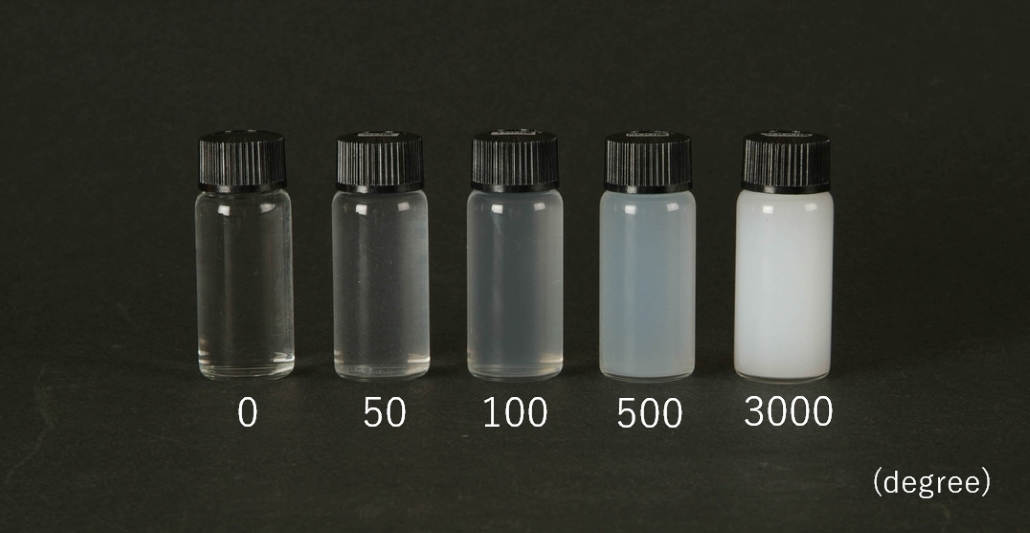FAQ : Environmental Sensors
Product selector guide
★★★ = Recommended Applicable, ★★ = Applicable, ★ = Conditionally Applicable, Blank = Not Applicable
| Measuring range | River water | Ground water | Non-filtration water | Filtered water | Membrane treatment water | Discharged water | Aeration tank | Industrial wastewater | ||
|---|---|---|---|---|---|---|---|---|---|---|
| Turbidity Sensor | TC-3000* > | 0~3000 FTU | ||||||||
| TC-500* > | 0~500 FTU | |||||||||
| TC-100 * > | 0~100 FTU | |||||||||
| TSC-10 > | 0.00~500.0 NTU/FNU | |||||||||
| TC-Mi > | 0.0001~9.9999 NTU 10.000~100.00 NTU |
|||||||||
| SS Sensor | TCS-1000* > | 0~1,00 mg/L | ||||||||
| TS-Mx > | 0~50,00 mg/L |
* : Sensor only
FAQ
Turbidity
- What is “turbidity”?
-
Turbidity is one of the indexes that show the level of “murkiness” in water and sewage treatment plants, rivers, industrial wastewater, and so on.
The more the water is turbid, the higher the turbidity, and the more clear the water, the lower the turbidity.
In addition, this turbidity is divided into visual turbidity, transmitted light turbidity, scattered light turbidity and integral sphere turbidity. When measured in comparison with kaolin standard solution, it is expressed as "degree (kaolin)", and when measured in comparison with formazin standard solution, it is expressed as "degree (formazine)".
Therefore, the measurement results of the obtained turbidity differ depending on the type of the standard and the measurement method. - How is the turbidity measured?
-
There are various ways to measure turbidity, and the following are examples.
(1)Visual turbidity・・・
The turbidity of the sample is determined visually by comparison with a standard solution.
(2)Transmitted light turbidity・・・
The intensity of the transmitted light that has passed through the sample is measured and determined from a calibration curve prepared using a standard solution.
(3)Scattered light turbidity・・・
The intensity of light scattered by the particles in the sample water is measured and determined from a calibration curve prepared using a standard solution.
(4)Integral sphere turbidity・・・
The ratio of the intensity of the scattered light by the particles in the sample water to the intensity of the transmitted light is determined and determined from a calibration curve prepared using a standard solution.
From the method of measuring the degree of turbidity with the human eye (vision), there is a method of measuring the degree of turbidity using optical technology,our products use the transmitted light method (photograph) and the scattered light method.
- What is the standard substance of turbidity?
-
The turbidity is an indicator of the degree of water turbidity. And there is a standard to express turbidity degree in turbidity.
If you say that the turbidity is 100, what is the standard value of 100?
The representative standards currently used include the following.
・Polystyrene turbidity standard
・Kaolin turbidity standard
・Formazin turbidity standard
The polystyrene turbidity standard is a turbidity standard that is often used for water supply measurement and the like, because the measurement unit is expressed as polystyrene turbidity "degree".
The Kaolin Turbidity Standard: The turbidity when 1 mg of kaolin is contained in 1 liter of purified water is expressed as “kaolin turbidity 1.” The unit is mg/L.
Formazin Turbidity Standard: The formazin solution specified in the JIS, with the unit being the degree of formazin. - What is the standard substance of turbidity?
-
Our Turbidity Sensor use a formazin solution as a standard solution.
- Which level of turbidity corresponds to what degree?
-
In the photos below, for example, use 100 degrees (formazine degree) as a measure of what degree of turbidity.
(* The photos are for reference only. The appearance changes depending on the background, light, etc.)
- Is there a correlation between turbidity and SS?
-
For turbidity and SS, there is no clear conversion formula such as SS is 2 mg / l when turbidity is 1 degree because the standard is different.
But it is quite common to see shared trends in measurement results, such as an increase in the turbidity value causing the SS value to also increase, and the two can be said to be relatively similar.
SS
- What is “SS”?
-
SS is an abbreviation of “suspended solids,” and is one of the indexes used in factory wastewater, etc.
The total volume of suspended solids, which have not been dissolved and cause murkiness in the water, is called the SS volume.
The measurement method is to filter a certain amount of water with filter paper, dry the remaining substance and measure the weight. - Is there a difference between SS measurement by hand analysis and measurement by SS Sensor?
-
Our SS Sensor is not a measurement method based on the official method. Therefore, the measured value obtained by our SS sensor can not be used as a proof of measurement.
However, performing continuous measurement is one of the most effective methods from the aspect of managing the trend of water quality, besides checking the usual drainage treatment situation.
Our SS Sensor has a correction function as shown in the figure below. By using the correction function, it is possible to match the measurement value of the SS Sensor with the measurement result by hand analysis.
- Is there a correlation between turbidity and SS?
-
The standards (indicators) for turbidity and SS are different.
It is quite common to see shared trends in measurement results, such as an increase in the turbidity value causing the SS value to also increase, and the two can be said to be relatively similar.
Contact phone number
- Headquarters
- +81-77-579-8680
Contact form
